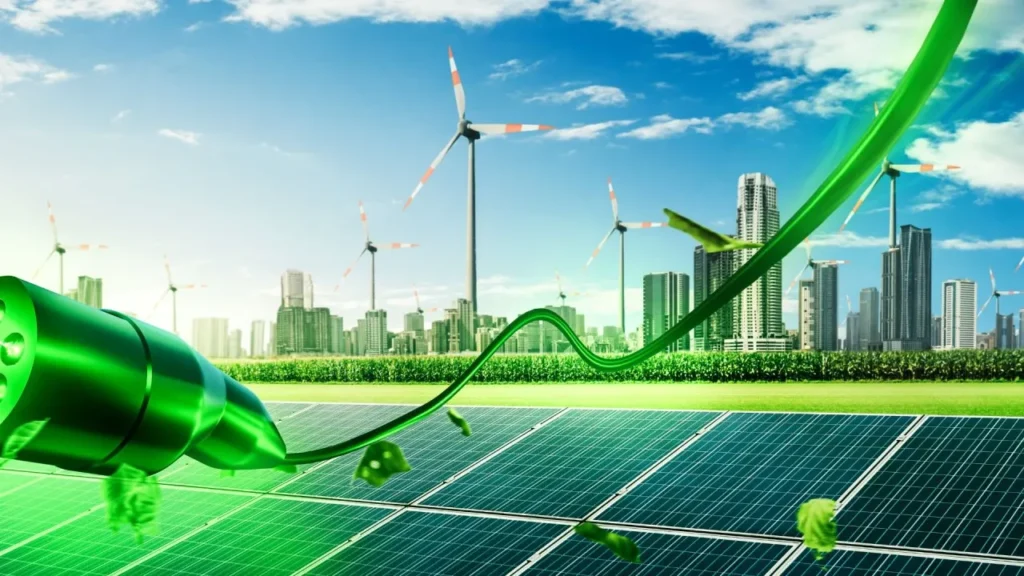By 2025, climate technology is expected to have evolved from a niche market to a major economic force. As global pressure mounts to combat climate change, venture capital (VC) firms are funneling record-breaking sums into renewable energy startups, carbon capture innovations, battery storage, and green infrastructure. The U.S. is at the center of this transformation, with focused businesses becoming some of the most sought-after investment targets.
The climate crisis, once seen as a regulatory burden or philanthropic cause, has now become a business opportunity—driving a surge in public-private partnerships, policy-driven incentives, and massive VC activity in sustainability tech. The result? A clean-tech boom that is reshaping the energy market, venture strategy, and the very definition of what a “valuable company” looks like.
🌱 From Environmental Idealism to Investment Gold Rush
A wide range of industries are included in technology, including:
- Renewable energy (solar, wind, hydro)
- Carbon removal and offset platforms
- Smart grids and energy storage
- Electric mobility and battery innovation
- Hydrogen energy and alternative fuels
- AI-powered emissions monitoring
- Circular economy tech (recycling, materials science)
In 2025, venture capital is treating climate solutions with the same excitement it once reserved for social media and software. According to industry trackers, global tech VC funding has surpassed $100 billion annually, with the U.S. claiming a major share due to legislative support and growing consumer demand for cleaner products.
💼 Policy Meets Profit: Why VCs Are Flocking to Green Tech
This investment surge is not accidental. A convergence of market demand, regulatory tailwinds, and technological maturity powers it.
Several key drivers are fueling the boom:
- Renewable startup companies are eligible for tax credits and subsidies under the Inflation Reduction Act and comparable laws.
- Corporate climate pledges are creating demand for carbon-neutral solutions.
- Public sentiment now favors sustainability—especially among Gen Z and millennial consumers.
- ESG (Environmental, Social, Governance) investing has become mainstream in institutional portfolios.
Venture capitalists now view tech as a multi-decade megatrend, with potential to reshape industries from manufacturing to finance.

⚡ Breakout Sectors in the 2025 Climate Tech Boom
While funding is spreading across the sector, a few standout categories are attracting the lion’s share of VC attention:
1. Battery Tech and Energy Storage
As the U.S. grid transitions to renewables, efficient storage is crucial. Startups focused on long-duration batteries, solid-state chemistry, and grid-level storage solutions are seeing major valuations.
2. Carbon Removal & Offsets
VCs are betting big on direct air capture (DAC), carbon mineralization, and marketplaces that help companies buy credible offsets.
3. Electrification of Transport
From electric trucks and aviation to e-bikes and autonomous delivery fleets, electrified mobility is in a golden era of funding.
4. Green Hydrogen
Hydrogen, particularly “green” hydrogen made using renewable electricity, is viewed as the future of clean industrial power and long-haul transport.
5. Circular Economy Platforms
Startups that recycle rare materials, upcycle waste, or enable product reuse (such as sustainable fashion logistics or refillable packaging tech) are gaining popularity.
🌎 Global Competition, Local Innovation
Although the U.S. leads in funding volume, Europe and Asia are hotbeds of climate tech innovation, too. American VCs are increasingly co-investing in cross-border deals and opening international-specific funds.
Domestically, climate tech hubs are thriving in:
- Silicon Valley – leading in AI and carbon analytics
- Texas – renewables and grid infrastructure
- Colorado & Midwest – battery innovation and agritech
- New York & Boston – finance-backed software tools
🧠 Role of Artificial Intelligence in Climate Solutions
AI is playing a key role in accelerating climate tech:
- Predictive models for grid balancing and weather impact
- AI-powered emissions tracking for industrial clients
- Automated monitoring of supply chain sustainability
- Optimization of energy storage and smart grid routing
VCs are especially excited about the intersection of AI and climate, dubbing it a “force multiplier” for innovation.
📉 Risks and Challenges for Climate Investors
Despite the optimism, this space isn’t without risk. Investors face challenges such as:
- Long hardware development cycles
- Policy volatility depending on political shifts
- High upfront capital requirements
- Technology scalability risks
That said, climate investors are building patient capital models—accepting longer timelines for massive long-term returns, especially in infrastructure, manufacturing, and energy sectors.
🚀 Exit Opportunities and the IPO Pipeline
Unlike past green booms that fizzled, 2025 has a robust tech exit environment. Several startups have successfully IPO’d or been acquired by major utilities, automakers, or tech giants looking to green their operations.
The rise of green SPACs, government-backed growth funds, and corporate venture arms has created a more stable runway for startups in this space.
🔮 The Future: Green Unicorns and Climate-First Business
With more climate unicorns (startups valued at over $1B) emerging, it’s clear that green business is no longer a charity or fringe idea. It’s core to the future of profitability and resilience.
In the next five years, we can expect:
- Deeper integration of carbon pricing into consumer products
- Hyperlocalized clean energy startups tailored to urban vs. rural needs
- AI-as-a-service for environmental compliance
- Decentralized solutions (community solar, microgrids)
In short, climate is not just a sector—it’s becoming a lens through which all business strategy is evaluated.
FAQs: Climate Tech VC Investments in 2025
1. What is climate tech?
Climate tech refers to technologies that reduce greenhouse gas emissions or adapt to the impacts of climate change. This includes renewable energy, carbon removal, sustainable transportation, energy storage, and more.
2. Why is venture capital so interested in this space now?
In 2025, climate tech offers massive long-term return potential. New legislation, growing consumer demand, and maturing technology have made it a profitable and socially vital sector.
3. How much is being invested into climate tech right now?
Over $100 billion globally in venture capital flowed into climate tech in 2025, with the U.S. accounting for a major share. That number is projected to grow annually.
4. What are the hottest climate tech sectors in 2025?
Top areas include energy storage (especially batteries), green hydrogen, carbon removal, electric vehicles, smart grids, and AI-powered sustainability platforms.
5. Are climate tech startups profitable yet?
Some are, especially in SaaS or carbon marketplaces. Others in heavy infrastructure or manufacturing require longer-term capital but are showing strong growth potential and securing lucrative partnerships.




